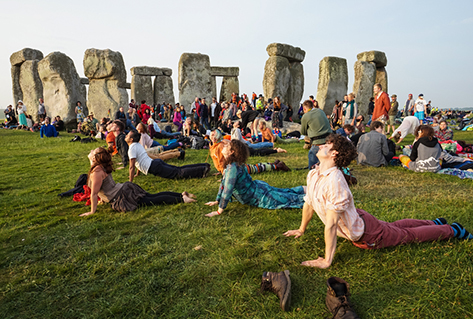- Nature: the town with the cleanest air in Europe is in Spain
- Report - raise the price of beach apartment rentals: the most expensive and cheapest destinations
If this were a normal year, these days thousands of faithful - believers and non-believers, hippies and curious people - would be coming to Stonehenge to celebrate the summer solstice. Last year, more than 10,000 people approached the iconic Neolithic monument between June 20 and 21 . The peak moments, as always, were the setting and later rising of the sun, in which "the first or last rays of the sun hide behind the horizon and the megaliths and align themselves , according to experts, in a unique and unique way that day".
Solstices are believed to have been held at Stonehenge for thousands of years, but the coronavirus pandemic is also going to make its mark in this corner of Wiltshire, an hour and a half west of London . This year, the ceremony marking the longest day of the year will be conducted entirely online and live through the English Heritage Facebook and Twitter accounts, the organization that manages this and 400 other historical monuments in the UK.
Connection to a spiritual place
You can enjoy the show twice. The first will start 30 minutes before sunset on June 20, equivalent to 8:26 p.m. UK time ( 10:26 p.m. Spanish time ). It will end during the morning of June 21, at 03:52 hours (5:52 Spanish time). Whoever prefers to see it later will have the option to do it delayed through the networks, since it will remain hung.
"We would have liked to organize the event as usual, but unfortunately we feel that we have no choice but to cancel," said Stonehenge director Nichola Tasker. "We hope that our live broadcast offers an alternative opportunity for people near and far to connect with this spiritual place at such a special time of year and we look forward to welcoming everyone next year."
A 360 tour of the site
Tasker has insisted that no one should go to the monument this solstice, despite the "attraction for many people." Those who want to take an immersive walk around the monument should be content to do so on this 360-degree tour.
On the summer solstice, the sun rises behind the so-called Heel Stone of Stonehenge, the old entrance to the complex, and the sun's rays are channeled towards the center of the monument. According to English Heritage, "Stonehenge's lineup shows that its builders had a sophisticated understanding of the weather , the seasons, and the sky.
Winter would have been a difficult time; they needed the return of longer days and heat to cultivate and feed their animals . Perhaps Stonehenge was a type of calendar, or a place where the seasons were celebrated. "
In accordance with the criteria of The Trust Project
Know more- tourism
- United Kingdom
- Summer
Forbidden to scream on the roller coaster or hug Mickey Mouse: this is how the theme parks reopen after the coronavirus
Holidays Reservations in Spanish campsites shoot up 70% for the summer (and many are for first-timers)
TourismWhere can we Spanish travel this summer? A guide across Europe from Portugal to Norway
See links of interest
- News
- Translator
- Programming
- Calendar
- Horoscope
- Classification
- League calendar
- Films
- Cut notes
- Themes
- Ruiz Zafon
- Unicaja - Barça
- Norwich City - Southampton
- Granada CF - Villarreal
- Mallorca - Leganés
- Seville - Barcelona

